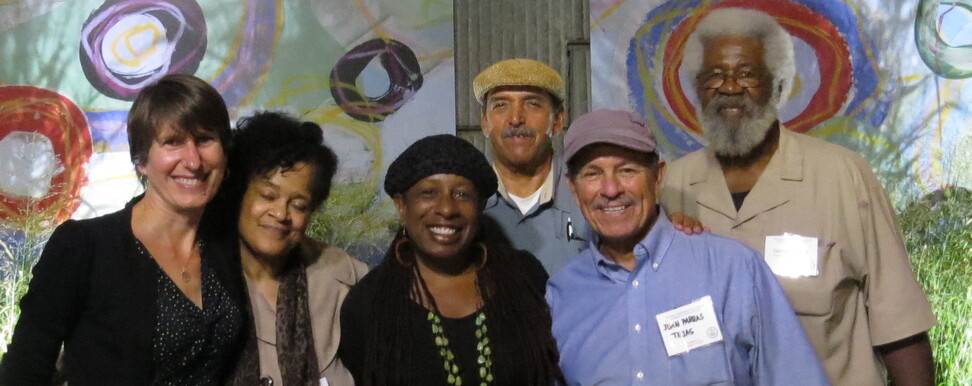A growing concern about the high amount of hazardous waste being dumped in predominately African-American communities that had been percolating for decades gained national attention in the 1980s. As outcry over these injustices grew, at the intersection of the Civil Rights and Environmental movements, the Environmental Justice movement was born.
Environmental Justice—a set of principles and a grassroots-led movement—arose in response to the disproportionate exposure of communities of color and low-income communities to harmful pollution, toxic sites and facilities, and other health and environmental hazards. While these people and communities have known about the hazards they face for a long time, beginning in the early 1980s new research helped document these harms and support action to address them. Grassroots leaders in many EJ communities began organizing and networking to address disproportionate toxic impacts wherever people live, work, play, learn, or worship.
Disproportionate toxic threats are still a daily fact of life in communities of color, low-income communities, and Indigenous communities across the United States, which Environmental Justice organizations work to address. In the simplest terms, achieving Environmental Justice means making sure all people have the opportunity to live the healthiest lives they possibly can.
’1964
The US Congress passes the Civil Rights Act, prohibiting the use of federal funds to discriminate based on race, color, and national origin.
’1965
The US Congress passes the Voting Rights Act.
’1987
The United Church of Christ Commission for Racial Justice issues the report Toxic Wastes and Race in the United States, the first national study to document the relationship between toxic waste facility siting and race.
’1990
The Clean Air Act Amendment passed by the U.S. Congress establishes the Risk Management Plan (RMP) program, the independent Chemical Safety Board, and U.S. Environmental Protection Agency’s (EPA’s) authority to establish design and operational requirements to prevent toxic chemical releases.
’1991
The First National People of Color Leadership Summit convenes in Washington, DC, leading to the “Principles of Environmental Justice.”
’1993
The EPA establishes the National Environmental Justice Advisory Council (NEJAC).
’1994
President Clinton signs Executive Order 12898, “Federal Actions to Address Environmental Justice in Minority Populations and Low-Income Populations.”
The Federal Interagency Working Group on Environmental Justice is established.
The United Church of Christ issues Toxic Wastes and Race Revisited, which strengthens the association between race and siting of toxic waste facilities.
’1996
40 people of color and European-Americans meet in Jemez, NM to hammer out common understandings between participants from different cultures, politics and organizations, resulting in the Jemez Principles for Democratic Organizing.
’1997
President Clinton issues Executive Order 13045, “Protection of Children from Environmental Health and Safety Risks.”
’2001
The Stockholm Convention on Persistent Organic Pollutants names an initial set of toxic chemicals to be banned worldwide. Native American and Native Alaskan organizations successfully advocate for inclusion of language on the disproportionate impacts on indigenous peoples.
’2002
The Second National People of Color Environmental Leadership Summit convenes in Washington, DC, attracting more than 1,400 attendees.
’2004
Coming Clean ratifies the Louisville Charter for Safer Chemicals: A Platform for Creating a Safe and Healthy Environment through Innovation.
’2005
Dozens of public health, labor, and environmental groups publicly endorse the Louisville Charter as a roadmap for policies to protect all communities based on principles of health and justice.
’2006
The Indigenous Environmental Network Meeting in Bemidji, MN, adopts the Bemidji Statement on Seventh Generation Stewardship.
’2007
The United Church of Christ releases the report Toxic Wastes and Race at Twenty, confirming and updating the findings of the original report.
’2012
The National Environmental Justice Advisory Council supports grassroots and labor groups in asking EPA Administrator Lisa Jackson to use the agency’s authority under the Clean Air Act to require chemical companies to adopt safer technologies at their facilities to prevent chemical disasters.
’2013
President Obama announces Executive Order 13650: Improving Chemical Facility Safety and Security, which directs federal agencies to develop recommendations for policy changes, best practices, information sharing, and federal, state, and tribal coordination.
’2014
The Environmental Justice Health Alliance for Chemical Policy Reform, Coming Clean, and the Center for Effective Government produce Who's in Danger? a report that demonstrates that residents of chemical facility "vulnerability zones" are disproportionately African American or Latino; have higher rates of poverty; and have lower housing values, incomes, and education levels than the national average.
’2017
EPA finalizes modest but important improvements to the Risk Management Program addressing and improving incident prevention program elements; enhancing the emergency preparedness requirements; and ensuring Local Emergency Planning Committees, emergency response officials, and the public can access this information.
Senator Cory Booker (D-NJ) joins local community leaders and advocates from across New Jersey and the nation in announcing the Environmental Justice Act of 2017, a landmark bill that would strengthen protections for communities of color, low-income communities, and indigenous communities.
’2019
A group of environmental justice and national environmental group advocates launch the the Equitable and Just National Climate Platform, which advances the goals of economic, racial, climate, and environmental justice to improve the public health and well-being of all communities, while tackling the climate crisis.
Senator Booker (D-NJ), a member of the Senate Environment and Public Works Committee, introduces the Environmental Justice Act of 2019 that would require federal agencies to mitigate environmental injustices through agency action and would strengthen the legal protections of those affected by environmental injustices.

